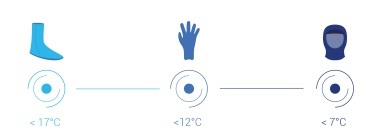Is there an explanation of what makes a wetsuit a canyoning wetsuit?
There are different types of wetsuits, all of which are used in different situations and different activities/sports. The most commonly used types of wetsuits:
- Shorty: covers the torso and has short sleeves and short legs.
- Shortarm: A shortarm has short sleeves and long legs.
- Full suit or steamer: covers the torso and the entire length of the arms and legs
Thickness of the wetsuit:
The thickness of the wetsuit determines to a large extent how warm the wetsuit keeps the body. The thickness of the wetsuit is indicated by two numbers, separated by a /. The number before the / indicates the thickness in millimeters of the part that covers the torso. This number is generally lower than the second number, which indicates the thickness in millimeters that cover the limbs. The first number is often thicker, because it largely determines the base temperature of the body. The area around the limbs is often thinner, because more flexibility and freedom of movement is required.
Example: The number 3/2 indicates that the part covering the torso is 3 millimeters thick, while the parts covering the limbs are 2 millimeters thick.
We have included an extensive(er) description in the Canyonzone Knowledge Base, see: How to choose a good canyoning wetsuit / canyoning suit?
Don't forget accessories:

Hood: a “hood” (headgear) serves to keep your head warm in (very) cold water. Your body cools down faster when you don't cover your head, so wearing a hoodie in cold water is definitely recommended.
Boots and Socks: Choosing the best canyoning shoes is not an exact science, but given the environmental variables we encounter while canyoning, there are a few things to consider. We look at some variables:
-How good the grip and adhesion is
-The durability of the shoe
-How comfortable are the shoes during approaches and descents
Socks: Canyoning socks in neoprene provide insulation for the feet.
Gloves: gloves are, of course, to keep your fingers and hands warm during cold conditions.
Neoprene shirt. You have them with both short and long sleeves. Neoprene shirts are generally worn when the water is too cold for just a wetsuit. Sometimes also single and mainly serves to protect the skin on the chest and against burns.
Overview Canyoning knowledge base: Go back.
CanyonZone
-
- Experts in canyoning & caving gear - ship worldwide
-
- Rent outdoor equipment
- New items in assortment
- Special offers
- Pre-ordering 2025
- NEW - Petzl Canyoning / Caving Line 2025
- 2nd hand canyoning caving articles
- Items / packages customer specific
- Giftcards of CanyonZone
-
- Canyoning (basic) equipment
- Canyoning equipment packages
- Luggage / Travel Bags
-
Canyoning Neoprene clothing
- Size charts by Brand
- Aventure Verticale (AV) size charts
- CE4Y neoprene size charts
- GUARA neoprene size charts
- Seland neoprene clothing size charts
- Newex neoprene size charts
- NRS neoprene size charts
- Vade Retro neoprene size charts
- Custom made neoprene wetsuit, required size data
- Canyoning Wetsuits
- Protective Canyoning Clothing
- Canyoning Neoprene Headgear
- Canyoning Drysuit / Undersuit
- Canyoning Neoprene shirts & shorts
- Canyoning Knee - elbow protectors / pads
- Canyoning Neoprene gloves
- Canyoning Neoprene socks
- Canyoning shoes
- Harnesses & Accessories
- Helmets outdoor sports
- Carabiners & maillons
- Descend devices
- Ascending / Rise along rope
- Pulleys
- Rope & webbing slings
- Anchoring & accessories
- Via Ferrata / Klettersteig sets
- Outdoor Gloves / (ice-)canyoning, caving, via ferrata
- Canyoning Back Packs, bags & duffels
- Drybags & Kegs, Boats
- Outdoor Knives & Scissors
- Safety in outdoor sports
- First Aid / Medical Articles
- Rescue in outdoor sports
- Camping, Bivouac & Backpacking
- Winter- / Ice Canyoning
-
Canyoning Books & Topographic Maps
- Map Pouch
-
Canyoning Guide Books
- Australia
- Austria
- France (including Corsica and La Reunion)
- Germany
- Greece (including Crete) / Balkans
- Israel
- Italy (including Sardinia)
- Jordan / Middle East
- Morocco
- New Zealand & Australia
- Portugal (including Madeira and Azores)
- Scandinavia
- Slovenia
- Spain (including Canary Islands and Majorca)
- United Kingdom (UK) / Scotland
- United States of America
- South America
- Switzerland
- Turkey
- Canyoning Techniques & Skills
- Canyoning Maps
- Outdoor Children's Books
- Outdoor DVDs
- Via Ferrata / Klettersteig books
- Repair & Maintenance
- Miscellaneous items outdoor sports
-
- Especially for Ladies
- Especially for Children
- Especially for Instructors and Guides
- Especially for Outdoor Sports Companies
- Especially for Underwater / Cave diving / Diving
-
- Caving (basic) equipment
- Caving equipments packages
- Caving Suits / Overalls
- Caving Under Suits
- Caving Boots / Wellies
- Caving Socks
- Caving Knee- and Elbow Pads
- Caving Gloves
- Headlamps & torches
- Caving Bags & BackPacks
- Tents and Bivi bags
- Caving & Potholing Books
-
-
Climbing related gear: on request
-
- Services
-
- CanyonZone New(s)
- CanyonZone Customer Service
- Contact about Assortment
- Business ordering at CanyonZone
- About CanyonZone
- CanyonZone's FAQ
- CanyonZone's Knowledge Base
- About CanyonZone, owner Gertjan van Pelt
- Works together with
- Link exchange
-
- Privacy
- Terms and Conditions
-
Terms and Conditions Rental
-


